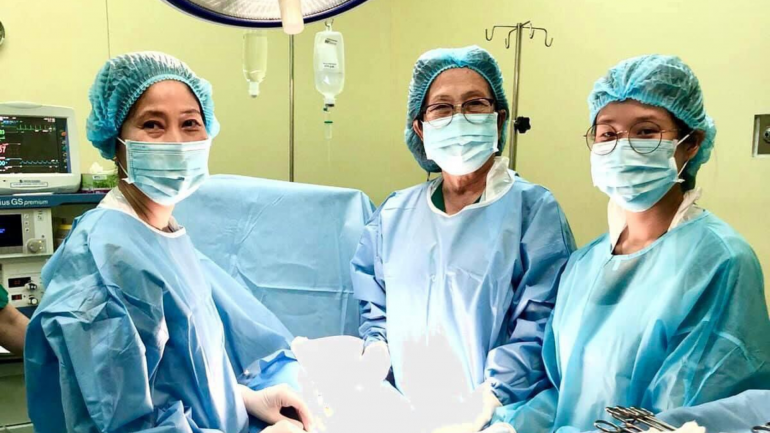Ramon Magsaysay laureate Dr. Phuong recalls the horrors of Agent Orange
In her lecture in Manila on November 13, Dr. Nguyen Thi Ngoc Phuong, a Vietnamese physician, recounted the horrifying impact of Agent Orange on the Vietnamese people.
Agent Orange, a toxic herbicide, was sprayed by the US troops over southern Vietnam from 1961 to 1971 during the war to remove the cover of the Vietnamese liberation forces in the forests by killing the foliage. The measure was also meant to destroy crops to starve the guerillas.
“In 1965, while serving as an intern at the Medical University of Saigon, now Ho Chi Minh City, I encountered a profoundly disturbing event during a nightshift,” Dr. Phuong said. “I delivered a severely deformed newborn - one without a brain, only a face. The size was horrifying.”
The mother cried when she saw her newborn and said ‘Oh God, I gave birth to a monkey,’ she recounted. The mother wept incessantly.
The entire family was devastated, the doctor said. They thought they had been punished for their sins.
Dr. Phuong could not eat or sleep for days due to the disturbing incident.
“It was not an isolated case,” she said. “I witnessed similar incidents frequently with a noticeable increase in congenital anomalies.”
The incidents prompted her to investigate the cause of unusual newborn deformities.
In 1974, Dr. Phuong found a report published by the US National Academy of Sciences.
After reading the report, she realized that the toxic chemical sprayed “repeatedly” by the US Air Force over southern Vietnam on a large scale could have a link to the deformed babies.
According to Dr. Phuong’s lecture, with the US Department of Veterans Affairs as a source https://vn-agentorange.org, the US military had sprayed over southern Vietnam with 19 million gallons of herbicides and 11 million gallons of Agent Orange contaminated with TCDD (2,37,8-Tetrachlorodibenzo-p-dioxin) for 10 years from 1961 to 1971.
As a result, an estimated 4.8 million Vietnamese were exposed to dioxin. The impact of the toxic chemical has lingered up to the fourth generation and even today.
An estimated three million Vietnamese suffered from Agent Orange, resulting in deaths, birth defects, and fatal diseases.
Her investigations in the 1980s established the connection between Agent Orange and the birth defects in newborns.
The dioxin is highly toxic and is linked to birth defects, cancers, and other conditions.
“However, the main victims were civilians in villages repeatedly contaminated when they ate crops and drank water that had been sprayed with Agent Orange,” Dr. Phuong said.
Agent Orange had accounted for 65 percent of toxic chemicals sprayed over southern Vietnam from 1961 to 1971, she noted.
Dr. Phuong noted that dioxin is an unwanted and unavoidable byproduct of the manufacturing process of 2,4,5-T, a synthetic herbicide used to control weeds and defoliate plants.
“There are many kinds of dioxin and all of them are toxic,” she said.
The dioxin has a half-life of seven to 11 years in the human body, Dr. Phuong explained. It enters the body by way of the skin contact, inhalation, and ingestion. The dioxin is also highly stable. It persists in soil, water, and animal and human fat tissues.
The TCDD is the most toxic dioxin, Dr. Phuong said, noting that the World Health Organization’s safe daily limit for dioxin is even smaller than one drop of water in a full Olympic-size swimming pool.
In her crusade against Agent Orange and to seek justice as well as look for solutions for the victims, she set up the Lang Hoa Binh, or Peace Village at the Tu Du Hospital. The Lang Hoa Binh became home to the Vietnam Association for the Victims of Agent Orange (VAVA).
In 2007, the American Public Health Association had recommended to the US government and organizations involved to provide resources for services for the disabled in areas where dioxin victims were concentrated, medical services and nursing services, community support organizations, medical equipment, and other services.
According to her lecture, since 2007, the US-Vietnam Dialogue Group has successfully negotiated approximately US$300 million for the cleanup of dioxin-contaminated airports in Da Nang and Bien Hoa, along with establishing a dioxin lab in Hanoi to analyze contamination levels.
Dr. Phuong not only helped victims of Agent Orange get medical care, but she also provided them with a refuge and supported them in seeking justice.
The VAVA was established in 2004 to seek justice for the Agent Orange victims.
“I have dedicated myself to working alongside three million Vietnamese victims through our networks across 64 provinces,” she said.
As of November 2023, VAVA has raised over U$172 million in cash and in-kind for assisting the victims of Agent Orange. The assistance includes financial aid, scholarship grants, health check-ups and treatment, vocational training, and employment.
“The victims of Agent Orange and their families are not just figures on a page,” she said. “They are real people, real lives. Each has his own struggle and story.”
Dr. Phuong was honored by the Ramon Magsaysay Awards this year for her dedication to uncovering the truth behind Agent Orange seeking justice for the victims, and assisting them through her research and work with the VAVA.
She called for an end to all forms of war.
“Together we can turn the page of humanity’s darkest chapter and write a new story,” Dr. Phuong invited the audience. “A story of peace, of healing, of unity. The pen is in our hands. Let’s write this new chapter together.”













